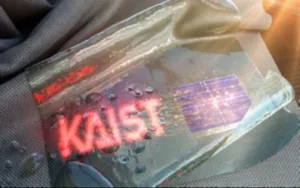Think about clothing and an image that comes to mind may be of textiles that are both wearable and washable. Problems arise, however, when the image transforms to that of so-called smart clothing.

As might be imagined, smart clothing is made from smart textiles. A smart textile is a fabric that enables electronic components such as a battery and a display to be embedded within the fabric.
The current generation of smart textiles commonly experience problems that relate to the penetration of moisture and oxygen. The conventional means to address these problems is through the use of an encapsulating barrier layer. Unfortunately, experience has demonstrated that washing, a process essential for a wearable textile application, cause conventional encapsulation barriers to deteriorate and, ultimately, results in deterioration in the performance of the smart device.
A team of researchers led by Eun Gyo Jeong of the School of Electrical Engineering, Korea Advanced Institute of Science and Technology (Kaist) (Daejeon, Republic of Korea) is working on a solution to this problem by developing a textile-based wearable smart display module technology that is washable and, in addition, does not require an external power source.
Recent results on this topic by the team are presented in an article entitled “Textile-based washable polymer solar cells for optoelectronic modules: toward self-powered smart clothing.” The article was published in Energy Environ. Sci., 2019, Advance Article. A copy of the article is available for purchase and can be found here.
A schematic and photograph of the washable smart display module developed by Kaist is presented in the figure below.
 Schematic and photograph of the Kaist washable smart display module.
Schematic and photograph of the Kaist washable smart display module.
The approach developed by Kaist to produce a practical wearable display module includes the integration of Polymer Solar Cells (PSCs) with OLEDs. Advantages of these technologies in wearable applications are that a PSC power source can provide stable power without an external power source and that OLEDs can be driven with just milliwatts of power.
The problem with these technologies in wearable applications is that they are both very sensitive to moisture and oxygen. To tackle this issue, the team developed an encapsulation barrier that can protect the smart display module through a washing process without losing its protective characteristics.
The new encapsulation barrier is deposited through Atomic Layer Deposition and spin coating of a SiO2 – polymer composite capping layer.
“The chemical stability imparted by a reaction between SiO2 and Al2O3 can prevent the phase transitions that are the cause of degradation. The proposed encapsulation barrier preserves its physical and chemical properties, such as thickness, roughness and permeability even after washing.”
The team’s article contains a great deal of detailed information on the formulation, structure and means of application of the encapsulating barrier layer. Also included is information on the means of testing and the results of the tests. In summary, with the Kaist approach, the team confirmed that textile-based wearable display modules including PSCs, OLEDs, and the proposed encapsulation barrier exhibited little change in characteristics even after 20 washings with 10 minute cycles. Moreover, the encapsulated device operated with high reliability even after being bent into a curve having a radius of 3mm. In fact, test samples demonstrated no deterioration in properties over 30 days even after being subjected to both bending stress and washing.
A video containing a demonstration of the water resistance of the Kaist smart display module is appended to the end of this article.
In their article, the team noted that the proposed material truly deserves the name “textile-based” in that it uses the textile itself as a platform. Inherent to this claim are the facts that the PSCs are very flexible and, in addition, that modules can be designed with the capability to produce all the power needed by controlling the physical area of the PSCs.
The researchers closed their article by stating that their recent work “suggests an important direction for the practical realization of wearable optoelectronic devices on real textiles.” -Arthur Berman
Korea Advanced Institute of Science and Technology, Eun Gyo Jeong, [email protected]

